StemUp: OCR A A level Physics 5.3: Oscillations
1/35
There's no tags or description
Looks like no tags are added yet.
Name | Mastery | Learn | Test | Matching | Spaced |
|---|
No study sessions yet.
36 Terms
What is meant by displacement in oscillatory motion? (1)
This is the distance an oscillating object is from the equilibrium position. Measured in meters.
What is meant by the amplitude in oscillatory motion? (1)
This is the maximum displacement for an oscillating object from the equilibrium position. Measured in meters.
What is meant by the period in oscillatory motion? (1)
This is the amount of time for an object to undergo one oscillation. Measured in seconds.
What is meant by frequency in oscillatory motion? (1)
This is the number of oscillations an object undergoes in a second. Measured in Hertz.
What is meant by angular frequency in oscillatory motion? (1)
This is the rate of change of angular position for an oscillating object. Measured in radians per second.
How is the angular frequency calculated? (1)
The angular frequency can be found as: ω = 2π / T or ω = 2πf as f = 1/T
What is meant by the phase difference in oscillatory motion? (1)
This is the fraction of an oscillation between the position of two oscillating objects. Measured in radians.
How is the phase difference calculated? (1)
The phase difference is found using: ∆t \ T x 2π
Where ∆t is the difference in how far the objects have gone through their time period and T is the time period.
What is meant by simple harmonic motion (SHM)? (2)
- This is a type of oscillation where the acceleration of the oscillator is directly proportional to the displacement from the equilibrium position.
- The acceleration acts towards the equilibrium position.
What is the equation for simple harmonic motion? (1)
This is: a = -ω^2 x
Where the a is acceleration of the object (ms^-2), ω is the angular frequency of the object (rads^-1) and x is the displacement of the object (m).
What does the negative sign show in the equation for simple harmonic motion? (1)
The negative sign in a = -ω^2 x shows that the acceleration is acting in the opposite direction to the displacement from equilibrium.
How is the frequency and period of an oscillating object found? (2)
- Set the oscillator (e.g pendulum or mass-spring system) into motion and use a stopwatch to time one oscillation (Time for 10 oscillations and divide for 10 to improve accuracy) this is the period.
- The frequency is found by using f = 1/T
What are the equations used to find the displacement of an object undergoing simple harmonic motion? (2)
There are two equations used which are the solutions to a = -ω^2 x:
- x = Asinωt
Where x is the displacement (m), A is the amplitude (m), ω is the angular frequency (rads^-1) and t is the time (s).
What is the velocity equation for an object undergoing simple harmonic motion? (1)
The velocity is given by the equation: v = ±ω √A^2 - x^2
Where v is the velocity of the object (ms^-1), ω is the angular frequency (rads^-1), A is the amplitude (m) and x is the displacement (m).
What is the maximum velocity for an object undergoing simple harmonic motion? (1)
This occurs when x = 0 (the equilibrium position) in v = ±ω √A^2 - x^2 so the maximum velocity is given by v_max = ωA
What is an isochronous oscillator? (1)
This is an oscillator where the period of the object (T) is independent to its amplitude (A). All oscillators undergoing simple harmonic motion are isochronous.
How are the displacement, velocity and acceleration related to each other graphically in simple harmonic motion? (2)
- The velocity is equal to the gradient of a displacement-time graph, the velocity of a given time is equal to finding the gradient at that point.
- The acceleration is equal to the gradient of a velocity-time graph, the acceleration of a given time is equal to finding the gradient at that point.
How is energy exchanged between forms during simple harmonic motion? (2)
- Energy is exchanged between the kinetic and potential forms.
- Maximum potential energy happens at the maximum displacement from the equilibrium position and maximum kinetic energy occurs at the equilibrium position.
When does the maximum kinetic energy occur during simple harmonic motion? (1)
This occurs when the object oscillating is at its equilibrium position.
When does the maximum potential energy occur during simple harmonic motion? (1)
This occurs when the object oscillating is at its maximum displacement from equilibrium (amplitude position).
What does the graph of energy against displacement look like for oscillating objects? (1)
The yellow line is potential energy and the blue line is kinetic energy. The displacement is in terms of amplitude.
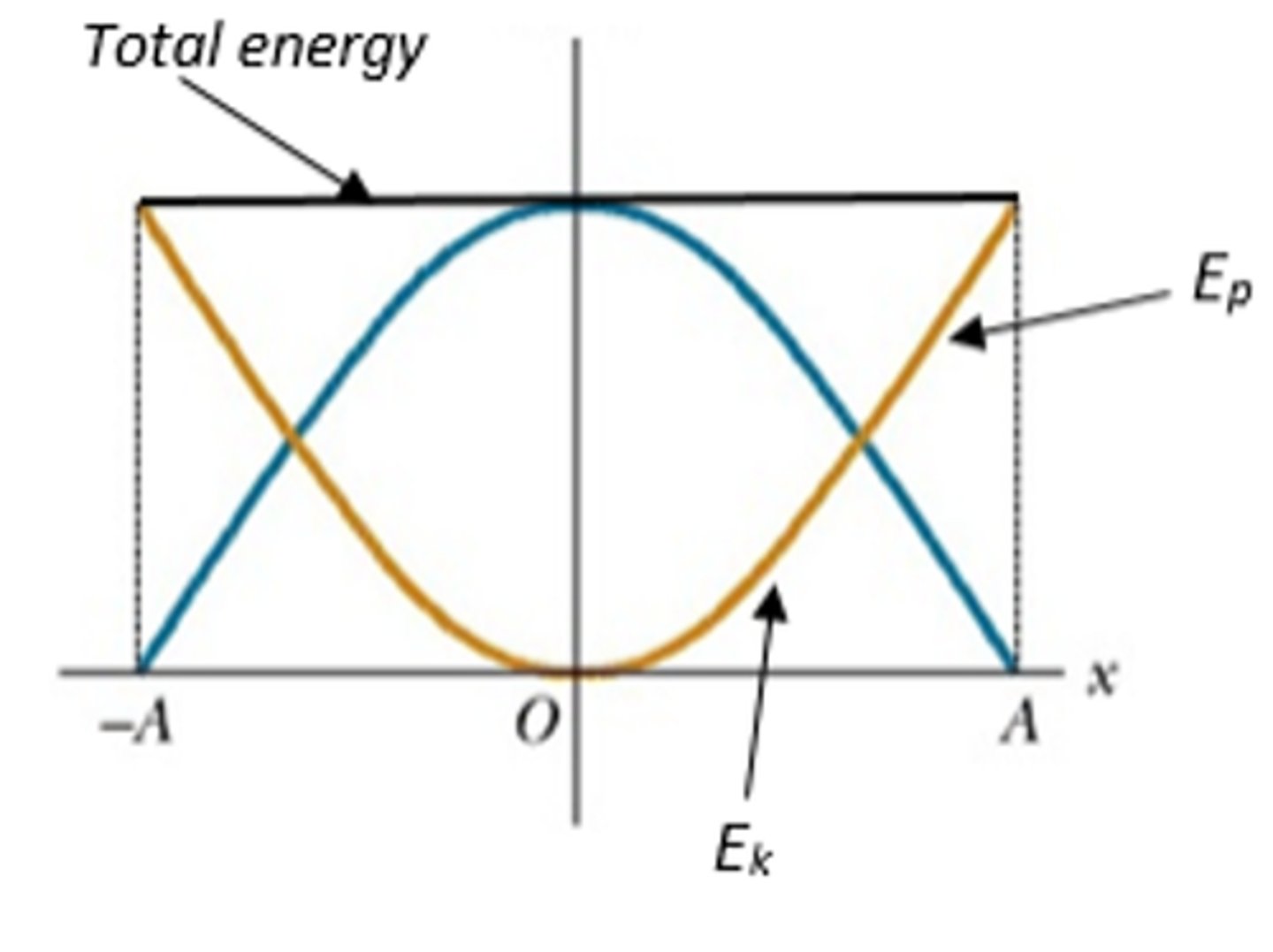
What is meant by a free oscillation? (1)
This is when an object oscillates at its natural frequency when it oscillates without external forces being applied to it.
What is meant by a forced oscillation? (1)
This is when an object is forced to oscillate at a specific frequency by a periodic driving force.
What is meant by damping? (1)
Damping is a process where the amplitude of oscillations decrease over time due to energy loss from the system such as energy transferred to the air due to air resistance.
What causes damping? (1)
It is caused by energy loss from the system such as energy transferred to the air due to air resistance.
What is meant by light damping and what does it look like on a graph of displacement over time? (1)
Light damping is where the amplitude of the oscillations decreases slowly over time and this looks like:
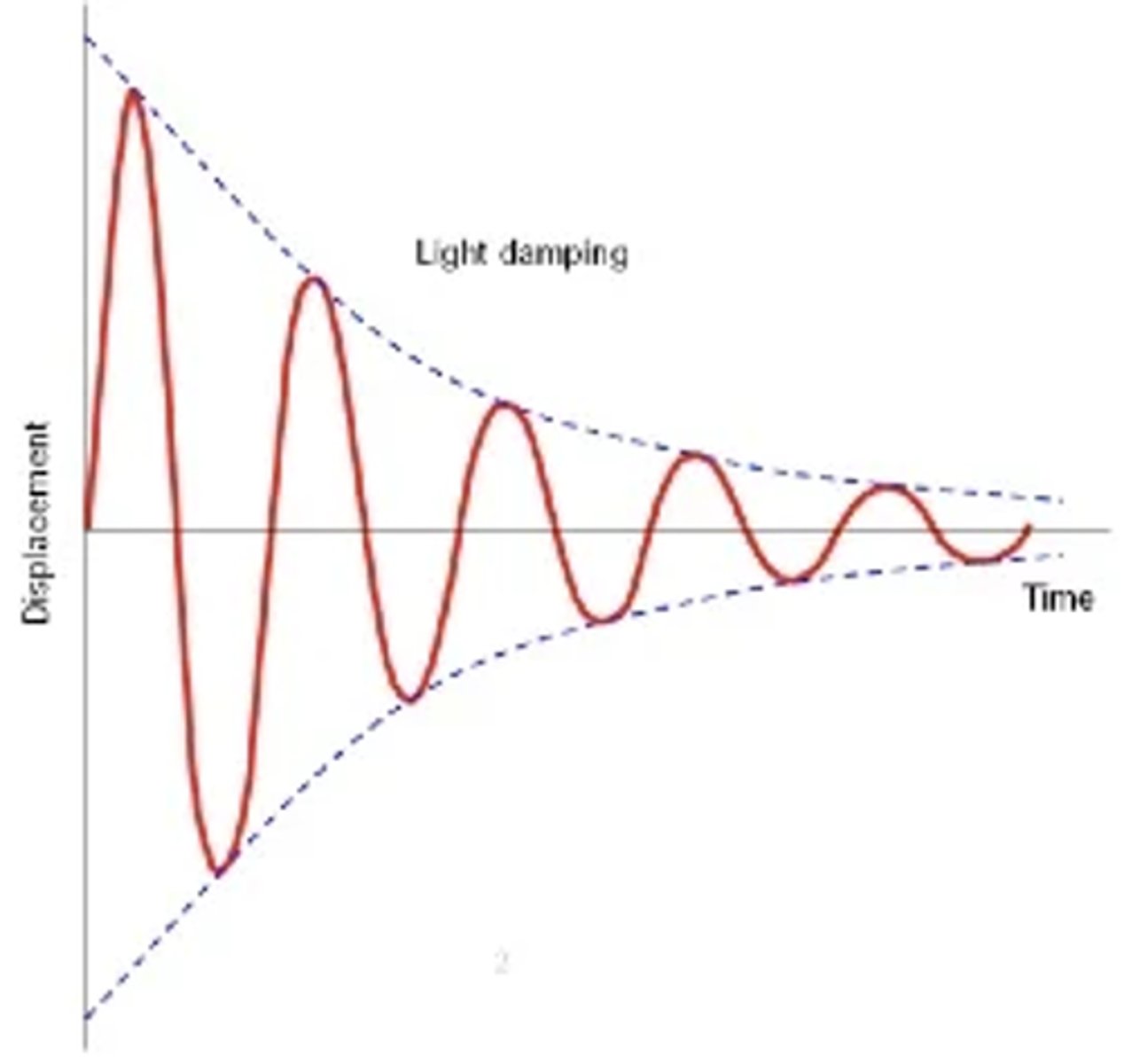
What causes light damping? (1)
Light damping is caused by natural causes such as air resistance (e.g a pendulum bob being stopped by air resistance when oscillating).
What is meant by heavy damping and what does it look like on a graph of displacement over time? (1)
This is where the amplitude decreases quickly over time and this looks like:
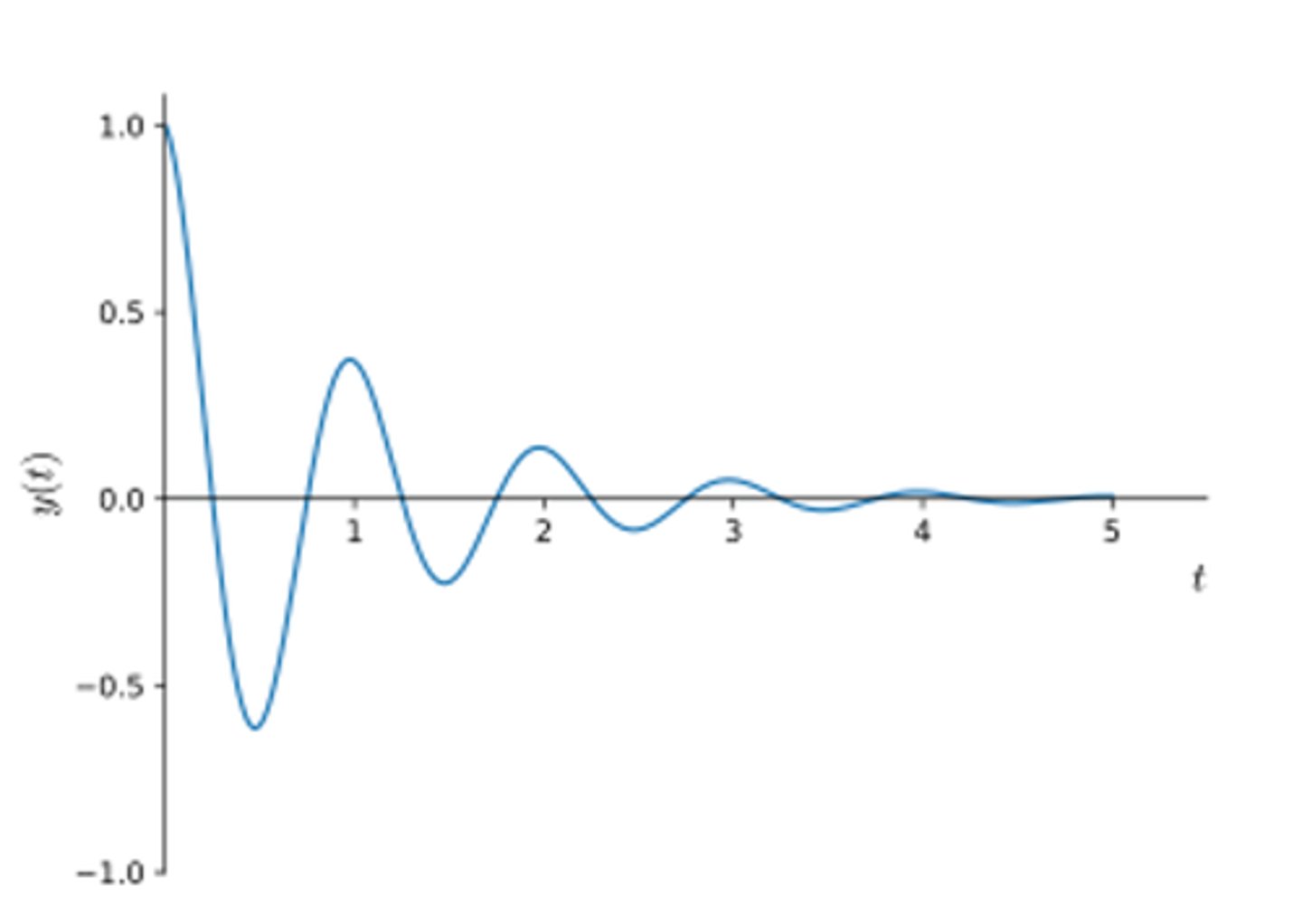
What causes heavy damping? (1)
Stronger drag forces such as drag in water will cause heavy damping on an oscillating object.
What is meant by critical damping and what does it look like on a graph of displacement over time? (1)
This is when the object is stopped before it even completes 1 oscillation, this looks like:
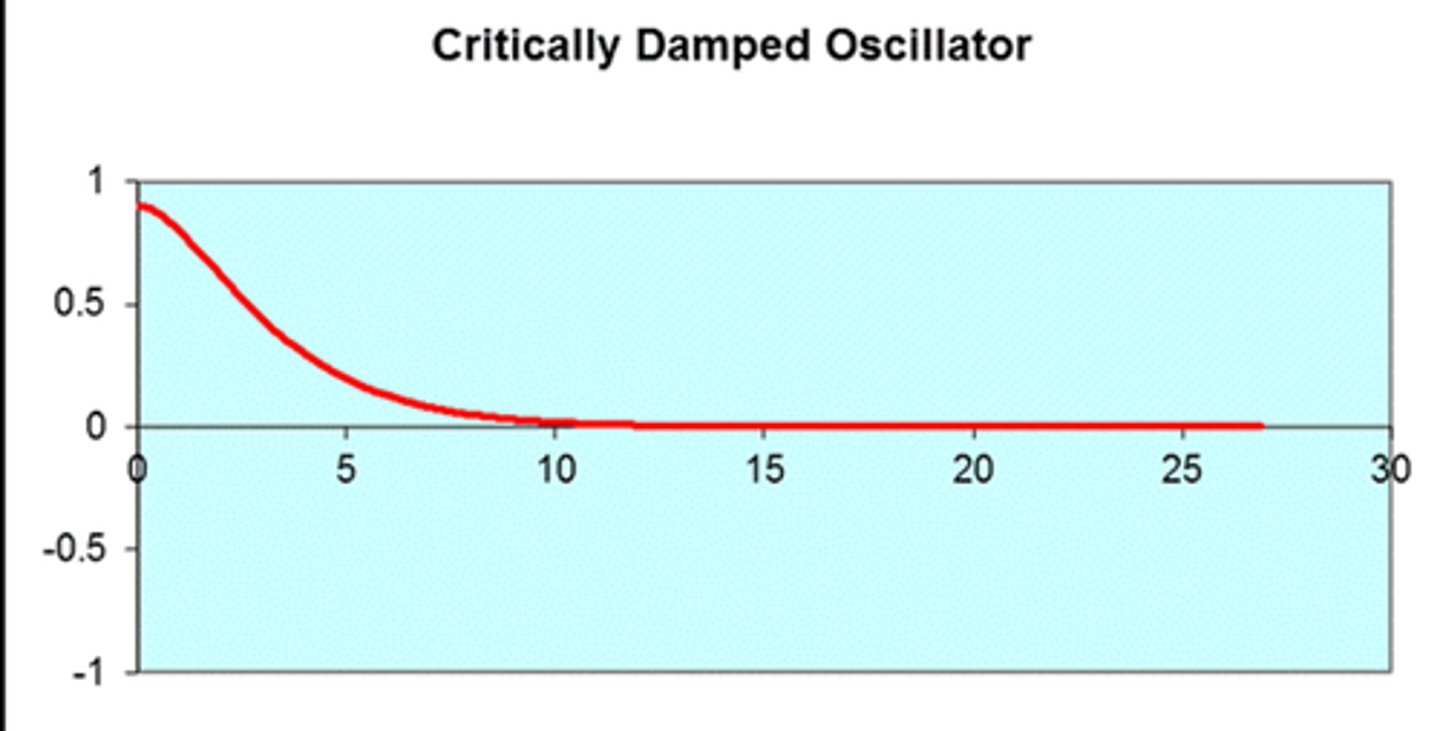
What causes critical damping? (1)
This is caused by very high drag forces that cause the oscillation to stop almost immediately.
What is meant by resonance? (1)
This is when the driving frequency of a force is equal to the natural frequency of an object and the object begins to oscillate at its maximum amplitude.
What is meant by the natural frequency of an object? (1)
This is the frequency at which if a force acts on an object with this driving frequency, the resonance occurs.
What does a graph of amplitude over frequency look like for forced oscillations? (1)
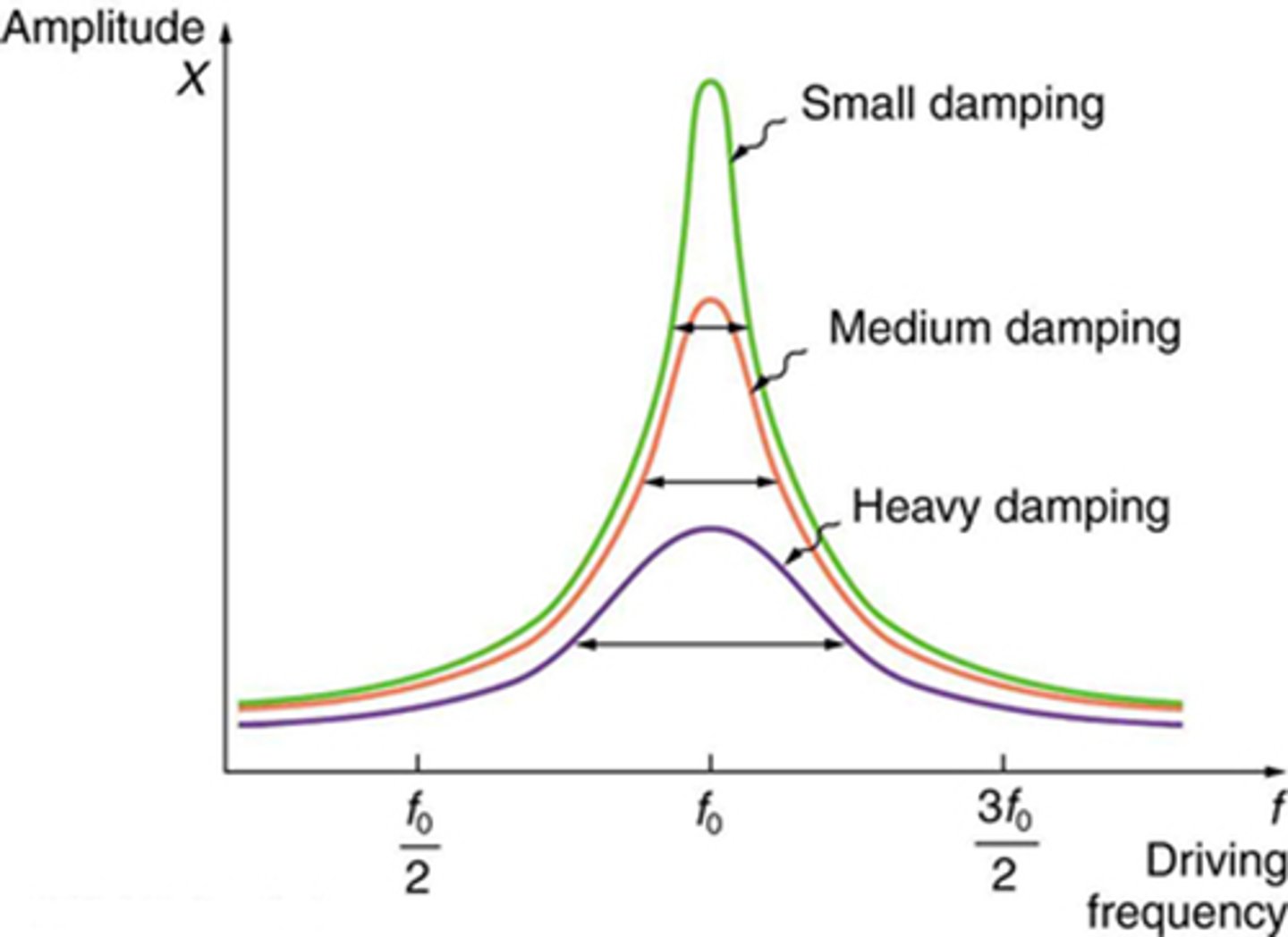
What does a graph of amplitude over frequency show about forced oscillations? (3)
- If the forced oscillation is at the natural frequency, the amplitude will reach a maximum due to resonance.
- Away from the natural frequency, the amplitude will rapidly fall.
- If there is damping on the system, the amplitude will also fall.
What are some practical examples of forced oscillations and resonance?
- Instruments can vibrate at resonance to produce a loud noise at the natural frequency.
- A bridge can vibrate at resonance due to forced oscillations (people walking) and it can shake (e.g Millennium bridge and the Tacoma bridge).